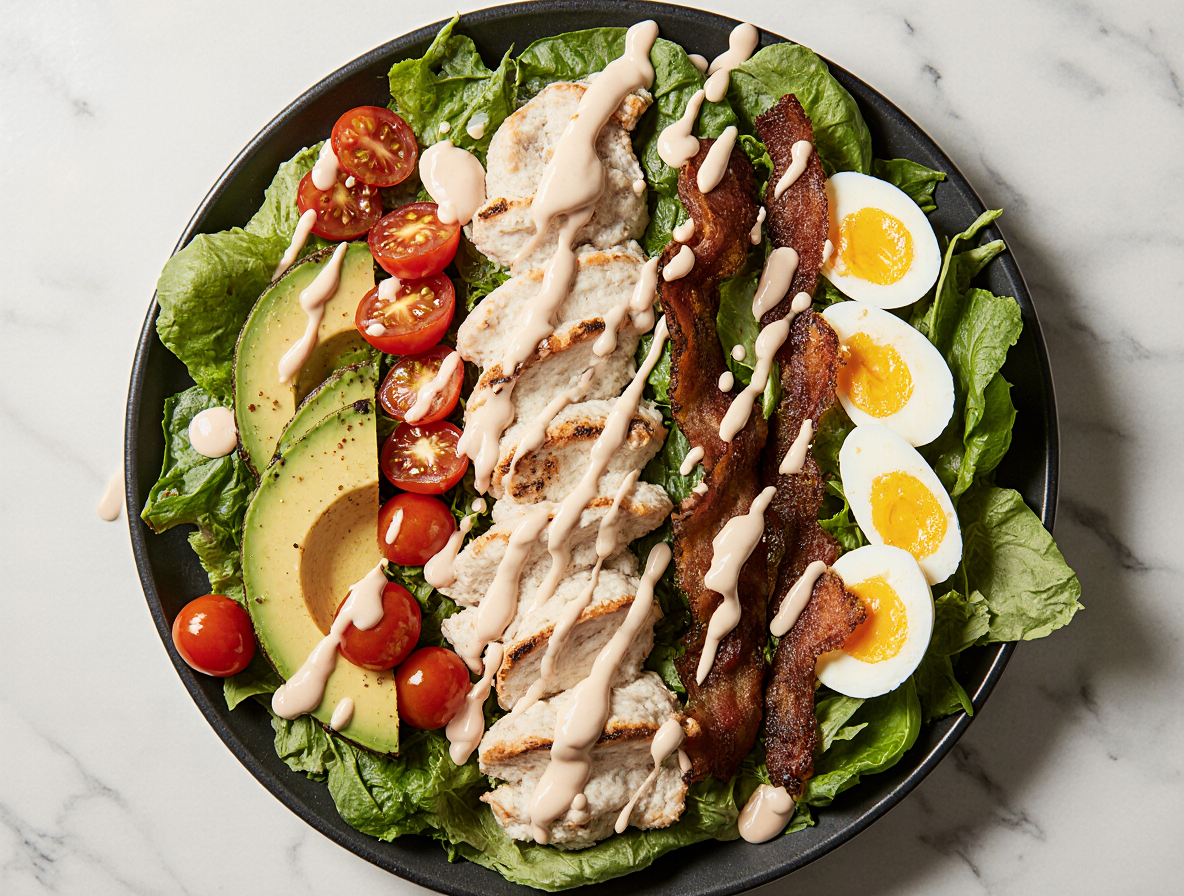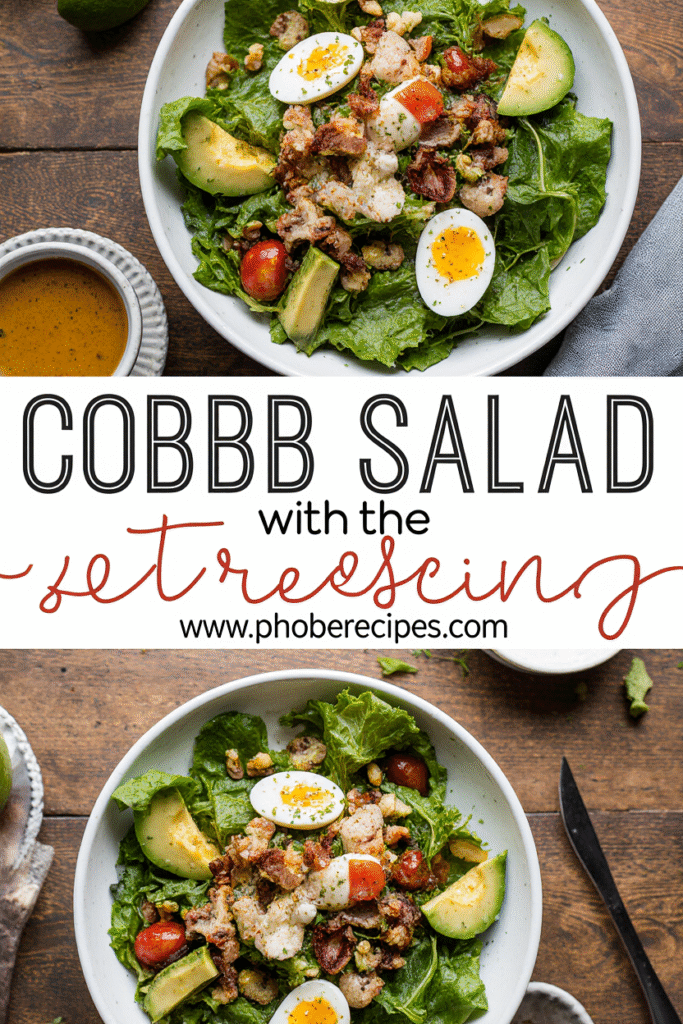Perfect Cobb Salad Dressing Recipe
The cobb salad dressing recipe we’re sharing today actually stands apart from standard dressings with its distinctive 50/50 oil to vinegar ratio, compared to the typical 1:3 or 1:4 proportion. Originally created by Bob Cobb in 1937 for his Brown Derby Restaurant in Los Angeles, this dressing truly is the secret that transforms a basic salad into something incredible.
What makes the best cobb salad dressing so special? For starters, it’s a simple yet powerful vinaigrette made with red wine vinegar, Dijon mustard, honey, olive oil, salt, and pepper. When paired with a protein-packed salad loaded with crisp lettuce, juicy tomatoes, chicken, bacon, boiled eggs, creamy avocado, and crumbled blue cheese, you get a perfect balance of flavors. The blue cheese specifically contributes about 130 calories to the dish, but adds an unmistakable richness to the traditional cobb salad dressing.
In this guide, we’ll walk you through our favorite cobb salad dressing recipe step by step. We’ll explain what makes it unique, share the essential ingredients you’ll need, and offer tips for perfecting your technique. Whether you’re preparing a light dinner or a filling lunch, this versatile dressing will elevate your salad experience.
What Makes a Cobb Salad Dressing Unique
Since its creation in the 1930s at the Brown Derby Restaurant in Hollywood, the cobb salad dressing recipe has maintained its distinctive character. This remarkable vinaigrette has become synonymous with one of America’s most beloved salads, offering a perfect balance that elevates its ingredients without overwhelming them.
The original Cobb salad dressing recipe
The story begins with Robert Cobb, owner of the Brown Derby Restaurant, who created the original cobb salad dressing in 1937. According to tradition, he threw together leftover ingredients, and the results were nothing short of legendary. The authentic recipe features a simple yet powerful combination of red wine vinegar, olive oil, Dijon mustard, lemon juice, and seasonings. Furthermore, many traditional versions include Worcestershire sauce and dry mustard for additional depth.
What makes the original cobb salad dressing recipe special is its straightforward preparation. You simply combine all ingredients, blend them thoroughly, then chill to allow the flavors to meld. The traditional dressing was specifically created to complement the rich ingredients in the salad – crisp greens, bacon, eggs, avocado, and notably, blue cheese.
Why the dressing is tangier than most
In contrast to standard vinaigrettes, the traditional cobb salad dressing uses a unique 50/50 oil-to-vinegar ratio rather than the typical 1:3 or 1:4 proportion. This deliberate tanginess serves an important purpose – it cuts through the richness of ingredients like eggs, avocado, and bacon, bringing everything together in perfect harmony.
The sharper profile is balanced with small amounts of sweetener – either sugar, honey, or maple syrup – just enough to take the edge off without making it overly sweet. Notably, the dressing often includes Dijon mustard, which not only adds flavor but also helps thicken the mixture, compensating for the reduced oil content.
How blue cheese influences the flavor
The relationship between blue cheese and the best cobb salad dressing is fascinating. While the original recipe featured Roquefort cheese known for its sharp, salty bite, modern versions use various blue cheese types. Some chefs incorporate the cheese directly into the dressing, while others prefer to sprinkle it separately over the salad.
Additionally, the choice of blue cheese significantly impacts the overall profile. For blue cheese newcomers, milder options like Blue Castello offer an accessible entry point. Meanwhile, Stilton provides a creamier texture with less aggressive flavor than Roquefort or Gorgonzola. The tangier dressing works brilliantly to offset the blue cheese’s richness – this intentional balance explains why many cobb salad enthusiasts find this combination irresistible.
Essential Ingredients for the Best Cobb Salad Dressing
Creating the best cobb salad dressing starts with choosing quality ingredients. Indeed, it’s the precise combination of these components that gives this dressing its distinctive character and makes it the perfect companion for the hearty cobb salad.
1. Olive oil and vinegar ratio
The foundation of any traditional cobb salad dressing lies in its oil and vinegar proportions. Unlike typical vinaigrettes that use a 3:1 or 4:1 oil-to-vinegar ratio, the cobb salad dressing typically employs a bolder 1:1 or 2:1 ratio. This higher proportion of vinegar creates that signature tangy profile essential to offset the rich ingredients in the salad. For the oil component, extra virgin olive oil is the most common choice, though some recipes incorporate a combination of oils such as canola or avocado for different flavor profiles.
2. Dijon mustard and its role
Dijon mustard serves two crucial purposes in the cobb salad dressing recipe. First, it acts as an emulsifier that helps bind the oil and vinegar together, creating a thicker, creamier texture. Second, it adds a subtle spicy kick that enhances the overall flavor profile. Most recipes call for approximately 1 tablespoon of Dijon mustard, although whole grain mustard can serve as an excellent alternative.
3. Shallots or garlic for depth
To build complexity, either minced shallots or garlic provide essential aromatic depth. Shallots offer a milder, more refined flavor than regular onions, making them ideal for this dressing. About 1 tablespoon of minced shallots or 1-2 finely minced garlic cloves will suffice. Especially for those who prefer a more subtle approach, shallots can be briefly pickled in the vinegar before adding other ingredients.
4. Sweeteners: honey vs. sugar
A touch of sweetness balances the acidity in the best dressing for cobb salad. Honey is particularly popular, with most recipes suggesting 2-3 tablespoons. Alternatively, granulated sugar (1-2 teaspoons) or maple syrup can achieve similar results. This small amount of sweetener doesn’t make the dressing sweet; instead, it rounds out the flavors and tempers the vinegar’s sharpness.
5. Optional herbs and spices
Fresh or dried herbs elevate the original cobb salad dressing recipe to new heights. Parsley, thyme, oregano, and cilantro are common additions. For those seeking extra dimensions, a pinch of black pepper, Worcestershire sauce (about 1/2 teaspoon), or even a dash of lemon juice can add brightness and complexity. Furthermore, some contemporary variations incorporate Parmesan cheese or red pepper flakes for added richness and heat.
How to Make Cobb Salad Dressing Step-by-Step
Making your own cobb salad dressing at home is remarkably simple. With just a few minutes of preparation, you’ll create a dressing that elevates your salad to restaurant quality. Let me walk you through the process from start to finish.
Step 1: Combine base ingredients
Begin by gathering all your measured ingredients. For most methods, you’ll want to combine everything except the olive oil first. If using a blender or food processor, add red wine vinegar, Dijon mustard, honey (or sugar), salt, pepper, and any additional flavorings like garlic or shallots. Alternatively, place ingredients in a wide-mouth mason jar with a secure lid. For those seeking a creamier variation, consider adding a small amount of mayonnaise or Greek yogurt alongside your vinegar base.
Step 2: Emulsify for a creamy texture
The key to the best cobb salad dressing is proper emulsification, which creates that velvety consistency. If using a blender, pulse on high speed until combined. During blending, slowly drizzle in your olive oil while the machine runs to create that perfect emulsion. The blender method is not just convenient—it’s a foolproof way to achieve a smooth, velvety vinaigrette that clings beautifully to each ingredient.
Don’t have a blender? No problem! Combine everything except oil in a bowl, then slowly whisk while drizzling in the oil. For the jar method, secure the lid tightly and shake vigorously for 20-30 seconds until the mixture emulsifies and thickens slightly.
Step 3: Adjust seasoning to taste
After initial blending, taste your traditional cobb salad dressing and adjust as needed. Remember that flavors will develop further as they meld together. For authentic flavor, consider chilling the dressing briefly before making final adjustments. The signature tangy profile should be evident—if it tastes too sharp, add a touch more sweetener; if too bland, a pinch more salt or pepper usually does the trick.
Step 4: Store properly for freshness
Transfer your finished cobb salad dressing recipe to an airtight container or dedicated dressing bottle. When properly stored in the refrigerator, your dressing will keep fresh for up to one week, with some recipes suggesting 3-4 days for optimal flavor. Some sources even indicate a shelf life of up to two weeks.
Before serving refrigerated dressing, bring it to room temperature for about an hour. Then re-emulsify by giving it a good shake or quick whisk to recombine any separated ingredients.
Tips, Variations, and Serving Ideas
Beyond mastering the basic cobb salad dressing recipe, these practical tips and creative variations will help you personalize this classic.
Make-ahead and storage tips
Preparing your dressing in advance saves valuable time. Most homemade cobb dressings remain fresh for up to 7 days when refrigerated in an airtight container. For optimal results, make your dressing 3-4 days ahead, storing it covered until needed. Prior to serving refrigerated dressing, allow it to sit at room temperature for about an hour, as this helps the ingredients blend together beautifully.
Remember to whisk or shake vigorously before using to re-emulsify any separated ingredients. Consequently, storing in squeeze bottles or mason jars makes this process much simpler.
Substitutes for blue cheese lovers and haters
Despite being traditional, blue cheese isn’t for everyone. For those new to blue cheese flavors, milder varieties like Blue Castello offer a gentler introduction. Conversely, those who simply cannot tolerate blue cheese have excellent alternatives:
- Feta cheese provides similar tanginess with lower calories and fat
- Goat cheese (chèvre) works beautifully, especially for those with penicillin allergies
- Cheddar cheese offers familiar flavor while maintaining textural contrast
Generally, whenever substituting milder cheeses, consider adding an extra tablespoon of oil to your dressing to reduce its tanginess.
Creamy vs. vinaigrette-style dressings
The traditional cobb salad dressing follows a vinaigrette style with red wine vinegar. On account of personal preference, many now enjoy creamy variations including ranch, blue cheese, or Caesar dressings. For homemade creamy options, incorporating mayonnaise or Greek yogurt into your base recipe creates wonderful texture.
Pairing with different Cobb salad versions
The best dressing for cobb salad can vary depending on your ingredients. For presentation purposes, try arranging ingredients in neat rows on a bed of lettuce, serving dressing on the side. This approach keeps leftovers fresh longer.
Equally important are these delicious variations:
- Shrimp or salmon Cobb (swap chicken for seafood)
- Vegetarian Cobb (add grains, beans and roasted vegetables)
- Southwest Cobb (incorporate black beans and Mexican cheese)
Conclusion
The perfect Cobb salad dressing truly elevates an ordinary salad into a culinary masterpiece. Throughout this guide, we’ve explored what makes this dressing stand apart—specifically its distinctive 50/50 oil-to-vinegar ratio that creates the signature tanginess needed to cut through rich ingredients like bacon, eggs, and blue cheese.
This classic recipe has stood the test of time since Bob Cobb’s ingenious creation in 1937. The balance of red wine vinegar, quality olive oil, Dijon mustard, and a touch of sweetness creates magic when paired with the protein-packed components of a traditional Cobb salad.
We certainly recommend making a larger batch of this dressing to keep on hand. After all, properly stored in an airtight container, your homemade dressing will remain fresh for up to a week, ready to transform any meal.
Additionally, don’t hesitate to experiment with the variations we’ve discussed. Whether you prefer the traditional vinaigrette style or want to try a creamier version with mayonnaise or Greek yogurt, the versatility of this dressing allows for personal customization.
Last but certainly not least, remember that the perfect dressing complements rather than overpowers your salad ingredients. The tanginess cuts through richness while the hint of sweetness brings balance—this thoughtful combination explains why the Cobb salad has remained an American classic for nearly a century.
Armed with this recipe and techniques, you can now confidently create restaurant-quality Cobb salads at home—bringing a taste of the original Brown Derby experience to your own dining table.
FAQs
Q1. What makes a Cobb salad dressing unique? A Cobb salad dressing is unique due to its 50/50 oil-to-vinegar ratio, which creates a tangier flavor profile compared to standard vinaigrettes. This tangy dressing perfectly balances the rich ingredients in a Cobb salad, such as bacon, eggs, and blue cheese.
Q2. How do you make a basic Cobb salad dressing? To make a basic Cobb salad dressing, combine red wine vinegar, Dijon mustard, honey, salt, and pepper in a bowl. Slowly whisk in olive oil until emulsified. Adjust seasoning to taste and refrigerate before serving to allow flavors to meld.
Q3. Can I make Cobb salad dressing ahead of time? Yes, you can make Cobb salad dressing ahead of time. When stored in an airtight container in the refrigerator, it can last up to a week. For best results, prepare the dressing 3-4 days in advance and bring it to room temperature before serving.
Q4. What are some alternatives to blue cheese in a Cobb salad? If you’re not a fan of blue cheese, you can substitute it with feta for a similar tanginess, goat cheese for a creamy texture, or cheddar for a familiar flavor. These alternatives maintain the textural contrast in the salad while catering to different taste preferences.
Q5. How can I customize my Cobb salad dressing? You can customize your Cobb salad dressing by adjusting the sweetness with honey or sugar, adding herbs like parsley or thyme for extra flavor, or incorporating ingredients like Worcestershire sauce or lemon juice for complexity. For a creamier version, try adding a small amount of mayonnaise or Greek yogurt to the base recipe.


